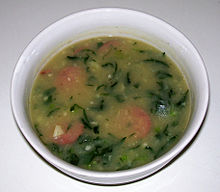Marrow stem cabbage
Collard Greens ( Brassica oleracea var. Medullosa . Thell ; . Syn : Brassica oleracea . Convar acephala . Var medullosa . Thell ) which is also called forage kale and Mark Kohl, a cultivar of vegetable Kohl with thickened drive, which in Germany, especially in the countryside Prignitz of the state of Brandenburg is cultivated. Most commonly, marrow stem kale is used as a fodder plant, less often in German-speaking countries it is used for human nutrition.
description
Marrow stem cabbage is a biennial herbaceous plant . The shoot axis begins very thinly on the ground and then gradually thickens in a club-like shape from 1 cm to 4 to 5 cm. With sufficient cultivation time, the plant can grow up to 2 m high. The plant is very hardy. The green leaves , sometimes slightly pink on the veins with anthocyanin, are 10 to 15 cm wide and 20 to 40 cm long. The leaf blade is smooth and pinnately indented towards the stem. The leaf margin is wavy to smooth. All cabbage varieties form an inflorescence with yellow flowers in the second year . These self-fertile varieties are pollinated by bees. Pods are formed as fruits .
Cultivation
If the climatic conditions are suitable, sowing outdoors is possible even before the ice saints in April . Weed control is an advantage at the beginning . Marrow stem kale grows in almost all soils with a pH value of 4.5 to 8. The soils should be permeable. Shady locations are not a major disadvantage, nor are very sunny ones. Pith stem cabbage can withstand very high temperatures, but also with habituation, low temperatures down to −15 ° C. In a limited area, the yield increases with the increase in the availability of nitrogen in the soil. At the same time, however, if there is sufficient soil moisture, the fiber or dry matter content of the plant decreases. It is grown as a second crop after grain and as a green manure plant to prevent nitrate leaching. This culture is one of the intercropping ( "nitrate catcher"). In spring the nitrogen is released again through rotting and is available for the new crop.
use
In German agriculture, the marrow trunk cabbage is used as fodder due to its high green mass yield. Cultivation is particularly interesting when less fresh green is growing back in autumn. It contains a lot of carotene . In the crop sequence, it is also suitable as a green manure to absorb residual amounts of nitrogen. It should be remembered that pith stem cabbage is a crucifer , just like other agricultural crops (e.g. rapeseed ). To such as carbon diseases clubroot to avoid should better phacelia be used. Mixed with other types of cabbage and soured like sauerkraut , it is also used in the kitchen as a knee cabbage . The thickened shoot can of course also be used.
In Italy , Greece and Turkey , it is also very popular for wrapping food to be cooked and is therefore often found in gardens of corresponding nationalities. The variant "Couve Galega" is typical for Portugal and Galicia (see Caldo verde or Caldo Gallego ).
swell
- ↑ GRIN Taxonomy for Plants online query. Germplasm Resources Information Network, accessed February 10, 2010 .
- ↑ Multilingual Multiscript Plant Name Database
- ^ Th. Gladis, K. Hammer: The Brassica oleracea group. 2003 ( Writings of the Association for the Preservation of Crop Diversity. 1), p. 25.
- ^ Plants for a Future
- ↑ RD Toosey, JW Usher: Influence of the Level of Nitrogenous Fertilizer on the Yield and Dry Matter Content of Marrow Stem Kale at Various Sowing Dates. In: Nature. Volume 211, No. 5045, 1966, pp. 216-217.
- ^ Th. Gladis: The neglected diversity of immigrant gardens in Germany - examples from Bonn. 2003.
Web links
- As a catch crop (PDF)


